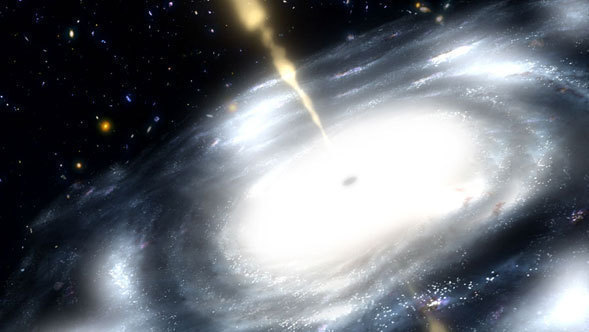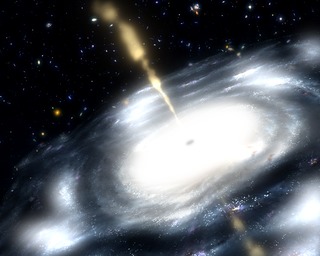
News Release • December 14th, 2007 • feature07-24 •
Written by Linda Vu
Spitzer Science Center
Billions of years ago, small galaxies across the universe regularly collided -- forcing the gas, dust, stars, and black holes within them to unite. The clashing of galactic gases was so powerful it ignited star formation, while fusing central black holes developed an insatiable appetite for gas and dust.
With stellar nurseries and black holes hungry both for galactic gas, a struggle ensued.
Astronomers have long suspected that these merging structures would eventually grow into some of the most massive galaxies in our universe. Now, NASA's Spitzer Space Telescope has finally identified several of these transitional, or "teenage," galaxies for further study.
"We believe that the most massive galaxies formed through mergers of spiral galaxies like our own Milky Way. Such events were much more common a few billion years after the big bang," says Dr. Anna Sajina, of the Spitzer Science Center in Pasadena, Calif. "This is the epoch we need to look at in order to study the galactic collisions."
Space is like a time machine; the farther away an object is, the further back in time astronomers peer to capture a glimpse of it. Using Spitzer, Sajina looked back to a few billion years after the big bang and spotted galaxies that are nearing the end of the merging process. She notes that these galaxies share a very unique characteristic -- all have massive central black holes that are smothered in dust and producing radio jets.
"What we essentially see in these galaxies is a competition for limited resources. Two processes, star formation and black hole accretion are competing for gas," says Sajina. "At the beginning of the collision, most of the gas will go towards forming stars. Towards the end of the merger, black holes will consume more gas."
According to Sajina, this struggle for resources is relatively short-lived, lasting only ten to 100 million years. Eventually, much of the gas will be pushed out of the galaxy by the powerful winds of newborn stars, stars going supernovae (dying in a cataclysmic explosion), or radio jets shooting out of central supermassive black holes. The removal of gas will stunt the growth of black holes by "starving'' them, and quench star formation.
"The exact process of quenching the extreme star-formation and black hole growth following such merger events is still poorly understood. What we need is to discover sources in the brief transition period after the radio jets have been turned-on, but while the galaxy and its central black holes are still embedded in their dusty cocoon," says Sajina. "The presence of copious amounts of dust in conjunction with strong radio jets in these newly discovered galaxies, makes them prime candidates for being such transition objects."
With Spitzer's supersensitive infrared spectrometer instrument, Sajina's team was able to determine the distance of these galaxies, pinpoint the epoch they live in, and see that they are extremely dusty. After sifting through an astronomical archive called the Sptizer First Look Survey, Sajina also noticed that some of these galaxies also had radio jets.
"The discovery of these transitional objects provides a new avenue for studying the co-evolution [development] of black holes and their host galaxies," she adds.
Sajina's paper was published in the September 2007 issue of Astrophysical Journal. Drs. Lin Yan, Mark Lacy, and Minh Huynh, all of the Spitzer Science Center, were co-authors of the paper.
Two other teams also studied systems like these. A recent study from the Spitzer Space Telescope's Great Observatories Origins Deep Survey (GOODS) also found hundreds of black holes producing X-ray jets, hiding deep inside dusty galaxies billions of light-years away. Their paper was published in the November 10, 2007 issue of Astrophysical Journal.
Results consistent with the GOODS study were also obtained by Fabrizio Fiore of the Osservatorio Astronomico di Roma, Italy, and his team. Their results appear in the Jan. 1, 2008, issue of Astrophysical Journal.





